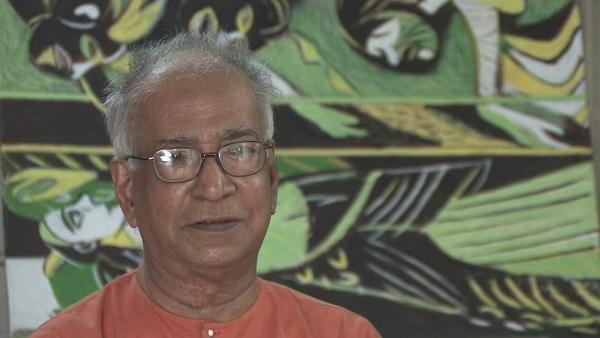NEXT STORY

Satyajit Ray
RELATED STORIES

NEXT STORY

Satyajit Ray
RELATED STORIES


|
Views | Duration | |
|---|---|---|---|
| 21. Organising an exhibition in Delhi | 54 | 09:28 | |
| 22. Working with Benode Bihari Mukherjee | 58 | 03:25 | |
| 23. Interest in Italian painting | 46 | 04:03 | |
| 24. Satyajit Ray | 90 | 02:36 | |
| 25. Leaving Santiniketan for Baroda | 42 | 01:51 | |
| 26. The partition of Indian and going to Baroda University | 38 | 04:11 | |
| 27. Life at Baroda | 58 | 04:06 | |
| 28. From Baroda to writing and the Slade School of Art, London | 48 | 02:52 | |
| 29. My wife, Susheela | 75 | 07:13 | |
| 30. London, language, tradition and the various influences on my art | 72 | 05:22 |


Did you share Benode Bihari's interest in this Italian painting at the time?
Well yes, I did. In fact, that interest in Italian painting was there even in Nandalal. Nandalal, in fact, when Nandalal was a student of the Calcutta Art School, he sort of talks about it in one of his later articles, that there was in the Calcutta school provision for learning all these things, that is mural processes, and even stained glass and things of that kind, which most of the art students did not take advantage of. And he was probably one of the few persons who went and worked there, and those days when they talk about it, on one side was the Jaipur method of arias fresco, and on the other side, they depend a lot on Cennino Cennini’s book on fresco painting, and most of the technical exercises they did were based on what that book sort of said. Along with that, they sort of tried to see what were the kind of works in Italy of that time, early or later. So they had also the interest, and then especially when they did visit, but then it was a time when Giotto was being discussed all over, and then they discovered all the other group painters, then the Sienese painters, then also Piero della Francesca. So that was part of the whole thing. In fact, Nandalal, when he started sort of making a sort of a disciplined drawing, he had sort of put two kinds of models in front of him, one was the sketch books of Leonardo, which had luckily Kala Bhavan had one of those very bulky books from that time, and the others were the engraving and paintings of Dürer. So many of the students were referred to these as sort of models to learn from, and then it turned out into the work of various others of that tradition, or you should say, if at all, the early renaissance tradition, or something earlier still. All that kind of exposure did help you to find out. I couldn’t do all the exercises that the other people did, but then I slowly tried to discover my own sort of interest in there, so I was more interested in the earlier painting, in the earlier sculptural thing, so down to gothic and Romanesque, and the Romanesque thing is what I tried to be most. That is why when I went to Europe, or through the little travel I did, I centred to find out what is where, sort of thing, related to Romanesque and Gothic.
KG Subramanyan (1924-2016) was an Indian artist. A graduate of the renowned art college of Kala Bhavana in Santiniketan, Subramanyan was both a theoretician and an art historian whose writings formed the basis for the study of contemporary Indian art. His own work, which broke down the barrier between artist and artisan, was executed in a wide range of media and drew upon myth and tradition for its inspiration.
Title: Interest in Italian painting
Listeners: Timothy Hyman
Timothy Hyman is a graduate of Slade School of Fine Art, London, in which he has also taught. In 1980 and 1982, he was Visiting Professor in Baroda, India. Timothy Hyman has curated many significant art exhibitions and has published articles and monographs on both European and Indian artists.
Duration: 4 minutes, 4 seconds
Date story recorded: 2008
Date story went live: 10 September 2010